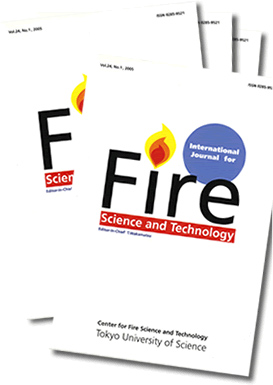International Journal for Fire Science and Technology

A peer-reviewed English academic journal specializing in fire, the “International Journal for Fire Science and Technology,” has been published by CFSaT (part of Research Institute for Science and Technology, Tokyo University of Science) since 1981. Through this journal, the Center has distributed fire-associated information to various research institutes and universities worldwide. The journal has been upgraded to a quarterly issued journal in 2004, and the journal became available online in 2007 via J-STAGE. The online journal has not only generated more traffic to the Center’s website, but has also gained recognition for the Center. As a global center of fire science education and research, the Center will report the Global COE Program activities and research outcomes through this journal. In the future, the Center will publish this journal more frequently and improve the quality of the content in order to become eligible for entry to the authoritative Thomson Scientific citation database so as to obtain an impact factor (IF).
Combustion engineering (combustion characteristics and fire-resistance design), Fire physics and chemistry, Heat transfer engineering, Fluid dynamics, Fire control (combustion control and smoke control), Risk engineering, Fire characteristics (flame behavior, thermal current, and compartment fire), Human behavior in fire, Structural fire resistance, Behavior of structural frame and components in fire, Fire safety design, and Urban fire among others.
Online Journal (via J-STAGE) can be accessed at:
AIMS AND SCOPE
International Journal for Fire Science and Technology is a global academic journal specializing in fire published by Center for Fire Safety and Technology, Tokyo University of Science since 1981. Through this journal, the center has distributed fire-associated information to research institutions and universities worldwide. The journal has been issued quarterly since 2004 and became available online in 2007 via J-STAGE. The online journal has brought more visitors to the center’s website and gained recognition of the center. By reporting our activities and research outcomes thorough the journal, TUS seeks to function as the global center of fire science education and research.
Contributions will be welcome on combustion engineering , fire physics and chemistry, heat transfer engineering, fluid dynamics, smoke control, risk engineering, fire characteristics (flame behavior, thermal current, and compartment fire), fire suppression,, human behavior in fire, structural fire resistance, behavior of structural frame and components in fire, fire safety design, and urban fire among others.
INSTRUCTION TO AUTHORS
SUBMISSION OF PAPERS
Manuscript and Application should be sent via E-mail to the Editor
Application Form can be obtained HERE.
| Research Paper: | Original research paper that provides academic and technical research outputs related to fire science. Research paper should have theoretical or demonstrative argument and clear conclusion. Research Paper is peer-reviewed. |
| Technical Report: | Report of research work, fact-finding survey, case study and statistical data etc. related to fire science. Technical Report should include technically valuable information and have clear conclusion. Technical Report is peer-reviewed. |
| Technical/Research Note: | Article that presents technical or research achievement or knowledge related to fire science. Technical/Research Note is not peer-reviewed. |
MANUSCRIPT PREPARATION
Language: All manuscripts must be written in English. General: Manuscripts must be prepared in WORD (.doc or .docx). The corresponding author identified in the application form and his/her E-mail address will appear on the top page of each article in the journal. Abstracts: An abstract not exceeding 200 words and five or less keywords should accompany the manuscript. Text: Follow the order when preparing manuscripts: title, authors, affiliations, abstract, keywords, main text (including figures and tables), acknowledgements, appendix, and references. Mathematical expressions: Equation numbers should appear in parentheses on the right-hand side of the equation and should be referred to within the text. References: The literature references should be brought together at the end of article, and numbered in the order of their appearance. In the text, references should be mentioned in square and superior brackets [ ]. The list of references must be given in the following style: 1. Author name(s), Paper title, Journal name, Volume and number, Page, Year 2. Author name(s), Book title, Publisher, City, Page, Year 3. Editor name(s), ed., Book title, Publisher, City, Page, Year e.g. C. Brown, M. P. Green, and S. Robinson, Study on Fire, Fire Science and Technology, Vol. 30, No. 1, 1-12, 2011 Abbreviations for the title of journals should be cited according to Chemical Abstracts Service Index: http://www.cas.org/products/print/cassipr/index.html Illustrations: Photographs, charts and diagrams are all to be referred to as "Figure(s)" and should be numbered with consecutive Arabic numbers in the order to which they are referred. They should be included in the text where they are mentioned and have descriptive captions. Line drawings: All lettering, graph lines and points on graphs should be sufficiently large and bold to permit reproduction when the diagram has been reduced to a size suitable for inclusion in the journal. Photographs: Original photographs must be supplied as they are to be reproduced in black and white. Tables: Tables should be included in the text where they are referred. Tables should be numbered consecutively and given a suitable caption. Footnotes to tables should appear below the table and be referred to by superscript lowercase letters. Units: The SI system should be used for all scientific and laboratory data; if, in certain instances, it is necessary to quote other units, these should be added in parentheses. Temperatures should be given in degrees Celsius.PROOFS Authors will receive proofs for correction which must be returned to editors by due date.
 Japanese
Japanese


